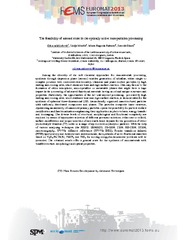Приказ основних података о документу
The feasibility of aerosol route in the optically active nanoparticles processing
| dc.creator | Milošević, Olivera | |
| dc.creator | Mančić, Lidija | |
| dc.creator | Rabanal, Maria Eugenia | |
| dc.creator | Ohara, Satoshi | |
| dc.date.accessioned | 2017-06-10T15:45:07Z | |
| dc.date.issued | 2013 | |
| dc.identifier.uri | https://dais.sanu.ac.rs/123456789/821 | |
| dc.description.abstract | Among the diversity of the soft chemical approaches for nanomaterials processing, synthesis through dispersion phase (aerosol) enables generation of ultrafine, either single or complex powders with controlled stoichiometry, chemical and phase content provided by high heating and cooling rates, short residence time and high surface reaction. This may favors to the formation of either amorphous, nanocrystalline or metastable phases that might have a huge impact in the processing of advanced functional materials having novel and unique structures and properties. Particularly, the opportunities of the hot wall aerosol processing, provided by high heating and cooling rates, short residence time and high surface reaction, is demonstrated for the synthesis of spherical three-dimensional (3D), hierarchically organized nanostructured particles with uniformly distributed components and phases. The particles composite inner structure, representing an assembly of nanosized primary particles, opens the possibility for particle surface modification and functionalization emphasizing their application in photovoltaics, energy transfer and bioimaging. The diverse levels of structural, morphological and functional complexity are explored by means of appropriate selection of different precursor solutions, either true or colloid, surface modification and proper selection of rare-earth based dopants for the generation of either photocatalytic titanium (IV) oxide or a range of up-conversion phosphor particles. With the help of various analyzing techniques like XRPD, SEM/EDS, FE-SEM, TEM, HR-TEM, STEM, nanotomography, UV-Vis diffusive reflectance (UV-Vis DRS), Fourier transform infrared (FTIR) spectroscopy and luminescence measurements, the synthesis of novel functional materials based on Y2O3:Eu,Yb,Er, NaYF4 and TiO2 for solving energy/environmental problems will be presented. The obtained results offer a general route for the synthesis of nanomaterials with tunable structure, morphology and optical properties. | en |
| dc.format | (2013) - | |
| dc.format | application/pdf | |
| dc.language | en | |
| dc.publisher | FEMS | |
| dc.relation | info:eu-repo/grantAgreement/MESTD/Integrated and Interdisciplinary Research (IIR or III)/45020/RS// | |
| dc.rights | openAccess | |
| dc.rights.uri | https://creativecommons.org/licenses/by-nc-nd/4.0/ | |
| dc.source | EUROMAT 2013: European Congress and Exhibition on Advanced Materials and Processes, Sevilla 8-13, October, 2013: CD Book of Abstracts | en |
| dc.subject | aerosol | |
| dc.subject | optically active nanoparticles | |
| dc.title | The feasibility of aerosol route in the optically active nanoparticles processing | en |
| dc.type | conferenceObject | |
| dc.rights.license | BY-NC-ND | |
| dcterms.abstract | Рабанал, Мариа Еугениа; Охара, Сатосхи; Манчић, Лидија; Милошевић, Оливера; | |
| dc.type.version | publishedVersion | |
| dc.identifier.fulltext | https://dais.sanu.ac.rs/bitstream/id/21777/818.pdf | |
| dc.identifier.rcub | https://hdl.handle.net/21.15107/rcub_dais_821 |

